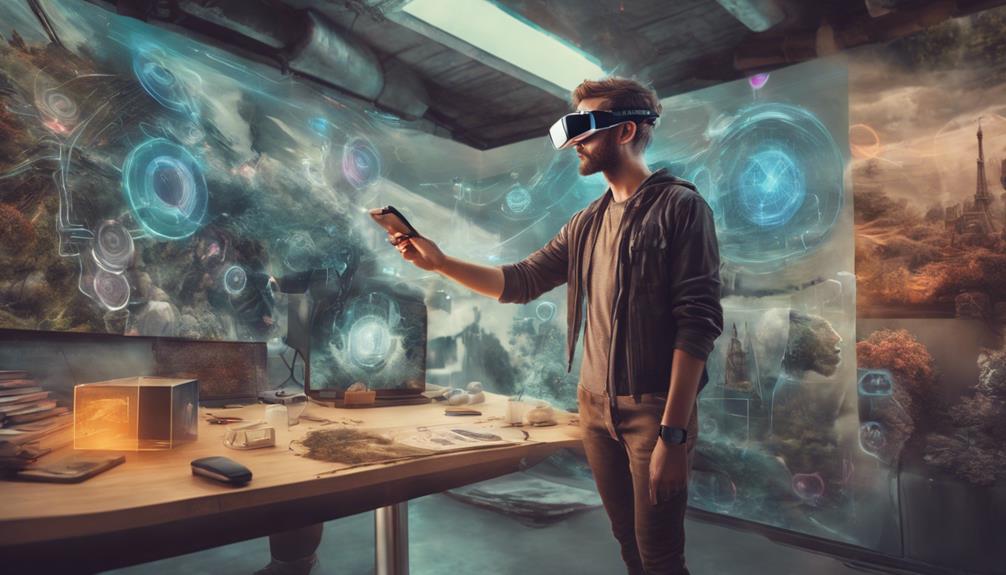Augmented Reality (AR) has rapidly evolved from a futuristic concept to a tangible technology reshaping various industries. The ability of AR to seamlessly merge virtual elements with the physical world opens up a realm of possibilities for enhancing human experiences and interactions. But what exactly makes AR stand out in the realm of technological advancements? Let's explore the intricacies of AR's functionality, its impact on different sectors, and the implications it holds for the future of human-computer interactions.
Key Takeaways
- Augmented Reality enriches human interaction by overlaying digital data onto the physical world.
- AR combines digital and 3D elements with reality, creating immersive experiences.
- Marker-based and marker-less AR offer dynamic and accurate digital overlays in real-time.
- AR technology enhances training, education, and various industries through interactive experiences.
Understanding Augmented Reality
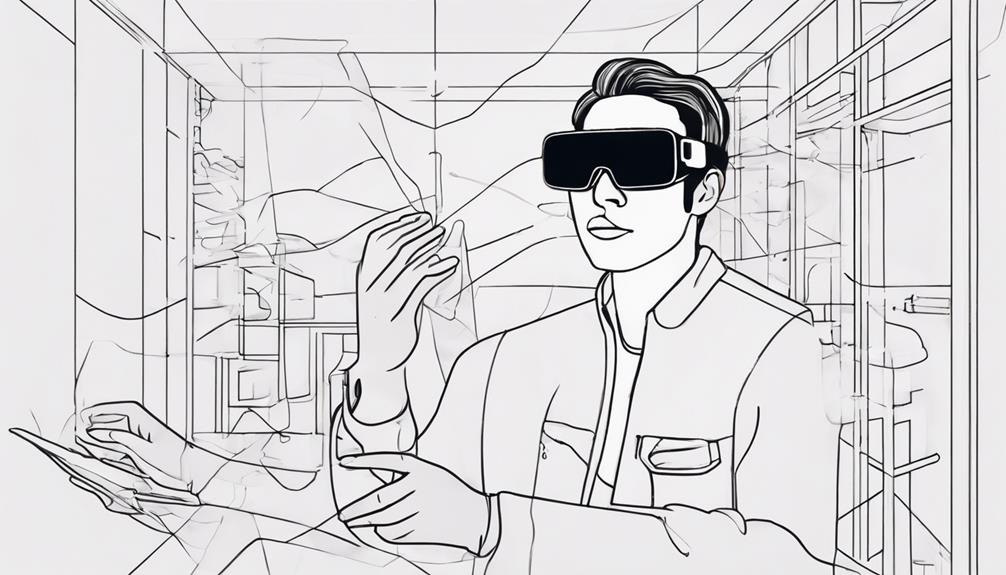
Augmented Reality, increasingly integrated into various technological applications, revolutionizes human interaction by superimposing digital data onto the physical world, enhancing user experiences through seamless blending of virtual and real elements. In the realm of AR, reality is dynamically augmented with digital information, offering users a unique and enriched experience within their environment. This cutting-edge technology merges the digital and physical worlds, providing users with a heightened sensory experience that is both interactive and immersive.
The integration of AR technology necessitates the utilization of specific hardware components such as processors, sensors, displays, and input devices to effectively align digital content with the real world in real-time interactions. Users can access AR through a variety of devices including smartphones, tablets, glasses, and contact lenses, allowing for versatile delivery options tailored to individual preferences. By seamlessly blending digital and 3D elements with the user's perception of reality, AR creates a transformative experience that opens new possibilities for interactive engagement and exploration.
Types of Augmented Reality
The categorization of Augmented Reality into distinct types is essential for understanding the diverse methodologies through which digital information is integrated into the physical world. AR technology seamlessly merges the digital and physical worlds, enabling real-time interactions and accurate 3D identification. Two primary types of AR exist:
- Marker-based AR: This type utilizes image recognition to identify pre-programmed markers, enabling the overlay of digital content onto specific objects. By recognizing these markers, AR technology accurately positions digital information within the physical environment.
- Marker-less AR: Unlike marker-based AR, marker-less AR does not require pre-programmed markers for object positioning. Instead, it recognizes objects in real-time using algorithms and sensor data, overlaying digital content based on environmental features. This type of AR is more dynamic and adaptable to various surroundings, making it a preferred choice for applications requiring flexibility in content placement.
How Augmented Reality Works
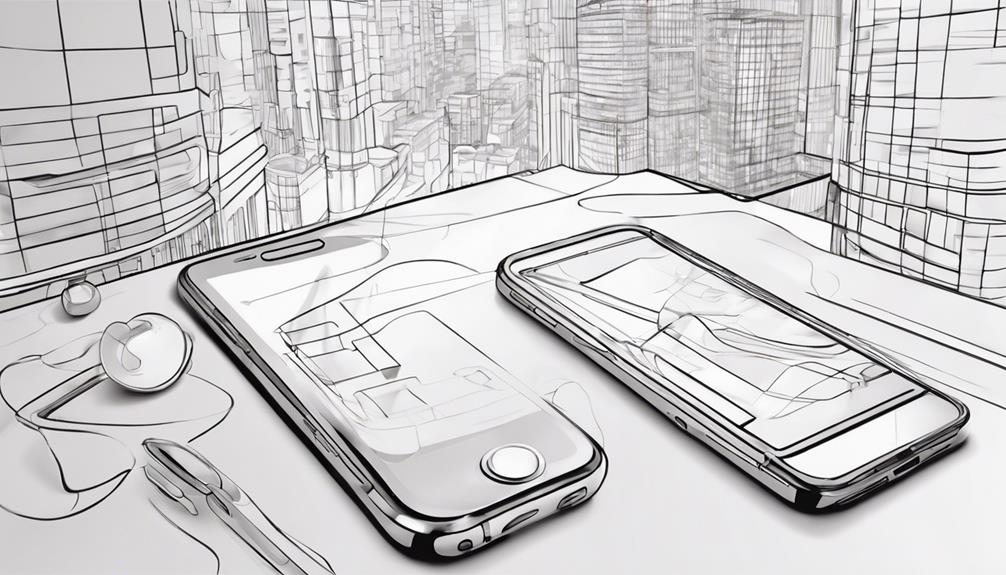
Within the realm of technology and digital innovation, the operational principles underpinning Augmented Reality (AR) elucidate a sophisticated integration of virtual and physical realms. AR superimposes digital information onto real-world objects, enabling interactive 3D experiences. This integration occurs within a cloud-connected ecosystem, particularly prevalent in Industry 4.0, where AR enhances functionality by connecting physical objects with digital content. AR-enabled devices, such as smart glasses, play a crucial role in this process by identifying physical objects and environments to overlay digital information seamlessly. The concept of a digital twin further bridges the gap between real and virtual environments, allowing for a synchronized interaction between the two. Real-time data is instrumental in AR applications, providing users with the ability to interact with AR objects or environments through gestures, voice commands, or touch inputs. The synergy of these elements within AR technology creates a dynamic and immersive experience for users, revolutionizing the way we interact with the digital world.
| AR Principles | Examples |
|---|---|
| Superimposing digital info | Overlaying information on real-world objects |
| Cloud-connected ecosystem | Integration within Industry 4.0 |
| Real-time data interaction | Gestures, voice commands for user engagement |
Integrating AR Into Training/Education
With the rapid advancements in technology revolutionizing various industries, the integration of Augmented Reality (AR) into training and education settings has emerged as a pivotal tool for enhancing learning outcomes and skill development. AR technology offers interactive educational experiences through digital overlays, enabling hands-on learning and improving comprehension. In addition, AR supports remote learning and collaboration, making it a valuable asset in industries such as retail, manufacturing, healthcare, military, and automobile. By incorporating AR into workplace processes, employees can gain a better understanding of tasks and procedures, leading to enhanced training efficiency and effectiveness. Overall, the integration of AR technology into training and education not only enhances the learning experience but also provides a practical approach to skill development in various fields.
AR Tools for Team Guidance
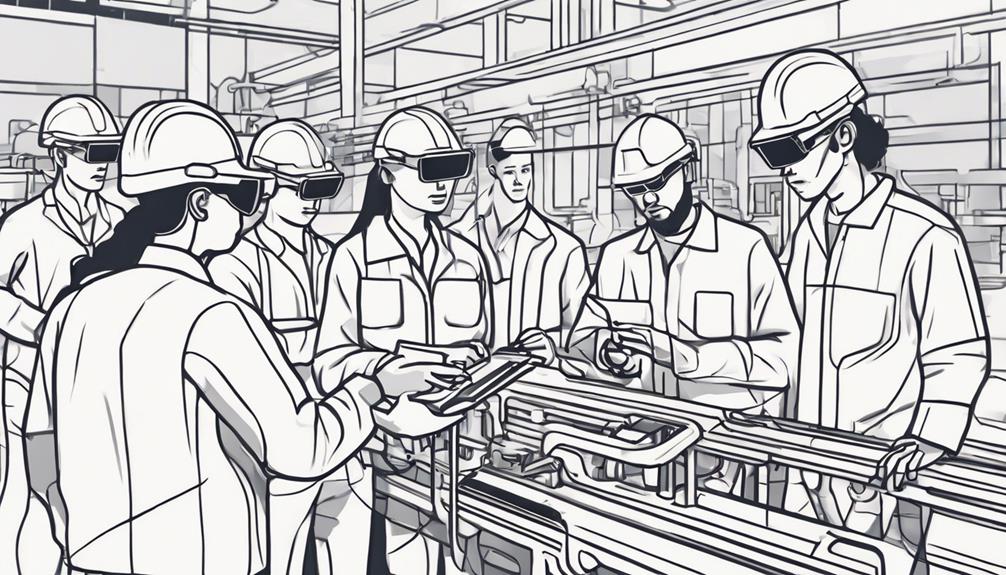
AR tools designed for team guidance play a crucial role in providing real-time assistance and enhancing team collaboration. These technologies offer step-by-step visual instructions that aid in navigating complex tasks efficiently. By enabling immediate feedback and support, AR tools contribute to improving team performance and operational effectiveness.
Team Training Benefits
Utilizing augmented reality tools for team guidance revolutionizes traditional training methods by providing real-time visual aids and instructions to enhance team collaboration and performance. These AR tools overlay digital information on the physical environment, offering interactive learning experiences that improve skill development and streamline training processes. Team members benefit from immediate feedback and guidance, leading to enhanced collaboration and overall team performance.
Benefits of AR Tools for Team Training:
- Real-Time Instructions: Team members receive immediate guidance during training sessions.
- Enhanced Collaboration: AR tools facilitate interactive learning, fostering better teamwork.
- Skill Development: By using AR tools, organizations can improve skill development and training efficiency.
Real-time Assistance Technology
Implementing real-time assistance technology in team guidance enhances collaboration and decision-making by seamlessly integrating digital information into the physical environment. Augmented reality technology enables the overlay of digital information onto the real world, providing visual guidance and instructions to team members. This real-time support facilitates improved communication and collaboration among team members, leading to more efficient decision-making processes. Industries such as manufacturing, construction, healthcare, and logistics benefit greatly from the use of AR tools for team guidance, as they help enhance efficiency and accuracy in various tasks. By accessing relevant data directly within their field of view, team members can work together more effectively and achieve better results in their respective fields.
Dynamics 365 for Collaboration
Enhancing organizational teamwork and communication, Dynamics 365 for Collaboration is a pivotal component of Microsoft's business applications suite. This platform offers a comprehensive set of tools and features designed to optimize collaboration within organizations. Here are some key aspects of Dynamics 365 for Collaboration:
- Teams Integration: Seamless integration with Microsoft Teams facilitates efficient communication and collaboration among team members.
- Document Collaboration: Users can collaborate on documents in real-time, enhancing productivity and ensuring all team members are working on the latest versions.
- Project Management: The platform provides robust project management features, enabling teams to plan, track progress, and achieve goals effectively.
Through real-time collaboration, file sharing, and integrated communication channels, Dynamics 365 for Collaboration empowers teams to work cohesively towards shared objectives. By accessing shared calendars, tasks, and project updates, organizations can enhance productivity and achieve greater efficiency in teamwork.
Contact Us for More Information
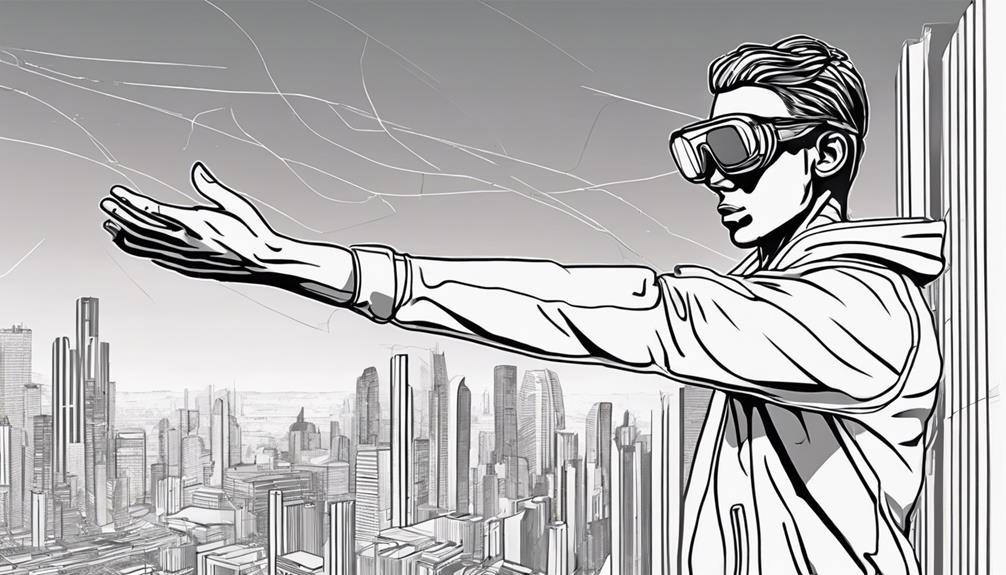
Building on the foundation of Dynamics 365 for Collaboration, exploring how augmented reality can revolutionize various industries becomes imperative for organizations seeking enhanced user experiences and operational efficiency. Contacting us for more information on augmented reality can provide valuable insights into its applications, benefits, and technological advancements. Our expertise can help you understand how augmented reality integrates digital elements into the real world, creating immersive experiences for users. By reaching out to us, you can gain knowledge about the hardware components, software requirements, and various use cases of augmented reality technology. Understanding these aspects can guide you in implementing AR effectively across different sectors to improve user experiences and operational efficiency. Contact us to discover how augmented reality can transform training, education, marketing, and other fields by seamlessly blending virtual and real-world elements.
Frequently Asked Questions
What Is Augmented Reality in Simple Words?
Augmented reality, in simple terms, overlays digital information onto the real world, blending virtual elements seamlessly with the physical environment. This technology offers interactive experiences, simulations, and visualizations in various industries. Users access AR through devices like smartphones or glasses, requiring components such as processors and sensors for optimal functionality. AR's applications span education, entertainment, healthcare, retail, and promise exciting advancements, integrating the virtual and physical realms for enhanced user experiences.
What Is an Example of Augmented Reality?
An example of augmented reality is Pokemon Go, a popular game that blends virtual creatures with the real world using GPS technology. Additionally, Snapchat filters overlay virtual elements onto pictures, enhancing user experience. Google Maps utilizes AR to provide real-time information and directions. IKEA Place allows users to visualize furniture in their homes. AR is also used in various fields like medical training, virtual try-ons in fashion, interactive museums, sports training, and augmented marketing strategies.
What Is Difference Between AR and Vr?
The difference between AR and VR lies in their immersive experiences; AR overlays virtual data onto the real world, allowing users to interact with both realms simultaneously, while VR engulfs users in a fully virtual environment. AR promotes real world integration for practical applications like retail product visualization and architectural project modeling. This distinction emphasizes AR's interactive experiences and user engagement compared to VR's complete immersion in virtual environments, paving the way for future possibilities in immersive technology.
What Are the 3 Types of Augmented Reality?
Marker-based AR, Markerless AR, and Projection-based AR are the three main types of augmented reality. Marker-based AR relies on pre-programmed markers for object recognition and positioning. Markerless AR uses algorithms and environmental features for real-time object recognition. Projection-based AR projects digital overlays onto physical surfaces, enhancing interactive experiences and real-world integration. These technologies are commonly used in mobile applications, holographic displays, and immersive interactions, relying on spatial tracking for accurate placement.
Conclusion
In conclusion, augmented reality technology offers a unique way to enhance our perception of the world by overlaying digital information onto our physical environment. Through various applications in industries such as retail, entertainment, and education, AR provides interactive and immersive experiences for users. By integrating virtual data with the real world, AR continues to evolve and revolutionize how we interact with technology and our surroundings. Further research and exploration into this field will undoubtedly uncover more innovative uses and benefits of augmented reality.
